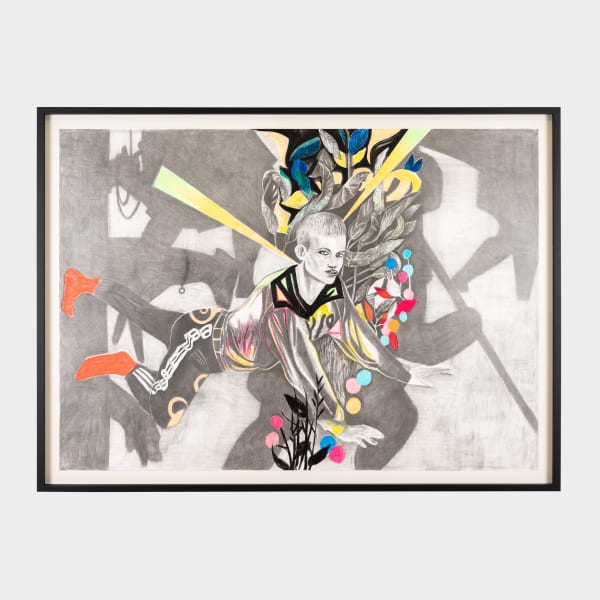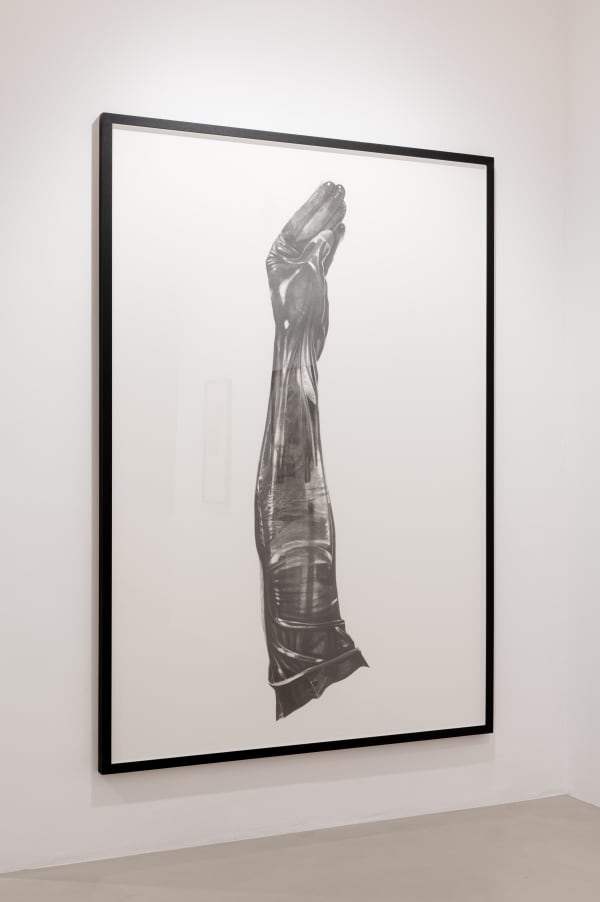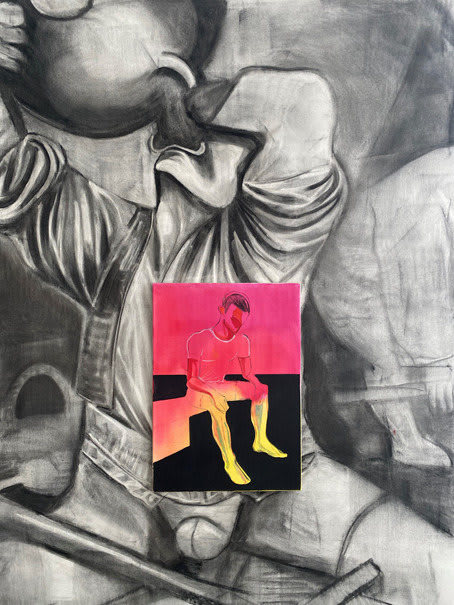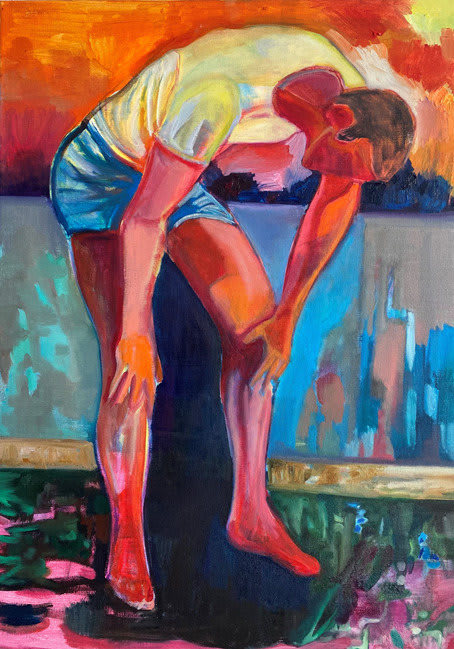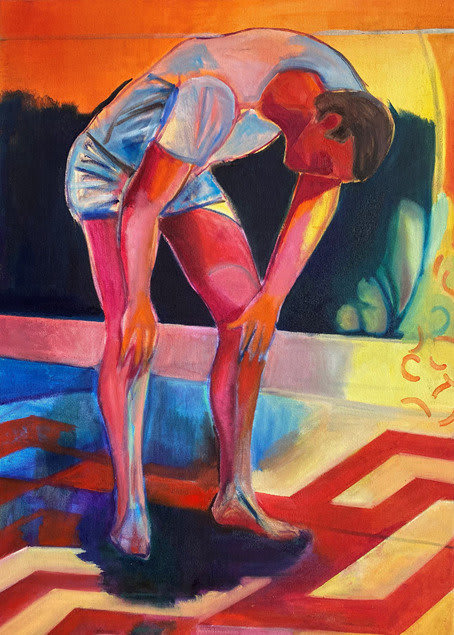marc bauer: second wind
Past exhibition
Overview
KETELEER GALLERY is very pleased to announce Second Wind 2021, the first solo exhibition by Marc Bauer with the gallery.
Press release
Marc Bauer (°1975. Geneva, Switzerland) is an internationally acclaimed artist, known mostly for his black and white drawings and large scale wall drawings and installations engaging the whole space in a total-composition. His distinct drawing technique, consisting of repeatedly erasing and adding layers of graphite and lithographic chalk, create dark atmospheric images evoking old photographs or time worn frescoes and are telling for Bauer’s fascination with art history, its iconography and (collective) memory. Recently, Bauer has started infusing more colour into his works and this new exhibition, consisting of older and brand new works, offers a beautiful variety in both style and subject matter while exposing a constant theme.
The title of the exhibition is ambiguous in many ways. In first instance, Second Wind clearly refers to the recurrent motive of the jogger pausing to catch his breath. In the face of enduring exertion, athletes can suddenly experience a new burst of energy just when it feels they had spent it all. Instantly the exhaustion is swept away, like a faint memory and the race seems to begin anew. But the title also refers to finding new energy on a more existential level. Amidst this global pandemic for example, we’ve been paused again and again and were confronted with ourselves while our patience and positive outlook were pushed to the limits. Every time however, we found a second, third and fourth wind in the face of a second, third and fourth wave.
The multidimensionality of such moments is explored further in the Second Wind series (2021). Each time, the colour setting and the surroundings of the jogger’s situation are altered and with it the perceived mood and associations, giving each anonymous looking figure, a unique and personal story. Ultimately, we’re inevitably isolated by the individuality of our experiences but also undeniably united by our shared human condition.
In the Exhaustion series (2021) the jogger motive is juxtaposed with fragments taken from Brueghel paintings (one of Bauer’s favourite artists), creating multi-level dialogues between the old and the new. Sometimes a shock, or a sudden realisation can make you pause as well, your eyes are opened and you instinctively halt to recalibrate your senses before you head on. These works deal with economy, gender and politics, the three pillars that rule our lives. In Capital we see a detail of Brueghel’s allegorical painting Big Fish Eat Small Fish (1556), a reference to our competition-based neoliberal economy which led to a historically wide gap between the rich and the poor. In Lust (from The Seasons, Summer 1526) we are confronted with an image of overt, almost sexual, masculinity. A man wearing a traditional Medieval codpiece, sat legs spread out, lavishes his thirst in a gluttonous way. A stark contrast with today’s revised sensitivity towards gender norms and roles. In Policy, the jogger is placed in front of The Blind Leading the Blind (1568), a reference to how we’ve blindly followed politicians lacking in long-term vision to this point in presence, where – especially ecologically – we’re all crashing together. These three confrontations are here to make us pause and think where we’re coming from, who we are and where we’re going.
In repeatedly appropriating and colliding different times and realities, Bauer poses the question of how old motives are perceived today and how they can be reactivated. According to him, these images haven’t lost their relevance and he believes they never will. But time still has an impact. How did these motives become icons in the first place?
In his Details series (2017) Bauer combines fragments of 3 paintings to create a new image. Picking and choosing details of art history, he assembles his own, more personal history. History, after all, is always selective. Some of the works have an added small image in the bottom left corner, small details of his personal life turned into icons in their own right. Which images of our present times will become part of history? What matters now and what will later? And do these questions impact how we feel about the present? Social media certainly seems to confirm this; objectifying every moment of our lives into a record for the future. On the left edge of the paper we see colours Bauer took from the paintings, a personal selection of favourites and yet another way to deconstruct and reconfigure what was given to allow for new associations.
In the Emperor Me, Glove (2015) series Bauer uses a very common and familiar image – an arm in a latex glove – and blows it up to human size, turning it into a kind of enigmatic statue, confronting us with an ominous ‘presence’ in the room. Its unusual size immediately makes us relate differently, it has an almost palpable effect on us, making us step closer and back again… Here, the image also confronts us with ourselves, our own body in relation to the image and perhaps with the strangeness of our own presence.
In the hallway we see two works of young boys posing with strange animals (a series from 2018). Two very different species are brought together in one scene, hanging out together in a seemingly familiar way. Animals like the crab and the iguana however, are from a very different step on the evolutional ladder and therefore have an immensely different consciousness than ours. Is it possible to bond with them? What are they thinking and how do they relate to us? The exotic will never cease to fascinate us but these curious creatures remain essentially incomprehensible to us. We’re staring at the past and the past is staring right back at us, in silence.
In the Boy series (2021), cut-outs from the same Brueghel paintings (mentioned above) reappear as a background and are contrasted with very modern images of today’s youth. In Boy and De zomer for example, an innocent looking boy is lying in on the ground, looking at us mysteriously, contrasting yet again with the strong masculinity of the Brueghel figure. In these three works however, we also see foliage and rays of colourful light surrounding the boys and colourful spheres opening up a new space in the image. It’s as if from the past new generations, and with it renewed energy, have sprung forth into existence.
On a huge red wall, Bauer drew Brueghel’s Triumph of Death (1562), a moralising and apocalyptic work (and one Bauer uses often) about how death inevitably annihilates all mundanities of life, how it’s everyone’s fate to perish, no matter what er who they are – how death doesn’t discriminate. On top of this wall drawing however, the painting Lily and Stilleven met doodshoofd (2021) is hung. Here, the classical vanitas (the skull taken from a Pieter Claesz painting from 1628) is reinvigorated with Bauer’s addition of lilies – a sign of purity and fertility – and rays of colourful light radiating from the skull. A message of hope perhaps and a hint at nature’s endless capacity to (re)generate life even in the most desolate situations.
Lauren Wiggers, 2021.
Installation Views
Works
-
 Marc Bauer, Boy and De parabel der blinden, 2021
Marc Bauer, Boy and De parabel der blinden, 2021 -
 Marc Bauer, Boy and De zomer, 2021
Marc Bauer, Boy and De zomer, 2021 -
 Marc Bauer, Boy and Jagers in de sneeuw, 2021
Marc Bauer, Boy and Jagers in de sneeuw, 2021 -
 Marc Bauer, Emperor Me, Glove I, R.P., 2021
Marc Bauer, Emperor Me, Glove I, R.P., 2021
-
 Marc Bauer, Emperor Me, Glove III, R.P., 2021
Marc Bauer, Emperor Me, Glove III, R.P., 2021 -
 Marc Bauer, Exhaustion; Capital, 2021
Marc Bauer, Exhaustion; Capital, 2021 -
 Marc Bauer, Exhaustion; Lust, 2021
Marc Bauer, Exhaustion; Lust, 2021 -
 Marc Bauer, Exhaustion; Policy, 2021
Marc Bauer, Exhaustion; Policy, 2021
-
 Marc Bauer, Lily and Stilleven met doodshoofd, 2021
Marc Bauer, Lily and Stilleven met doodshoofd, 2021 -
 Marc Bauer, Second Wind, (sitting) Blue, 2021
Marc Bauer, Second Wind, (sitting) Blue, 2021 -
 Marc Bauer, Second Wind, (sitting) Pink, 2021
Marc Bauer, Second Wind, (sitting) Pink, 2021 -
 Marc Bauer, Second Wind, (standing) Green, 2021
Marc Bauer, Second Wind, (standing) Green, 2021










